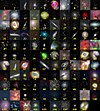IC 2602

|
|
| IC 2602 | |
| AladinLite | |
| Constellation | Keel of the ship |
|
Position equinox : J2000.0 |
|
|---|---|
| Right ascension | 10 h 42 m 56.5 s |
| declination | -64 ° 23 ′ 39 ″ |
| Appearance
|
|
| classification | II3m |
| Brightness (visual) | 1.6 mag |
| Number of stars | 60 |
| Brightest star | (Theta) θ Carinae mag |
| Physical data
|
|
| Affiliation | Milky Way |
| distance | 480 ly |
| diameter | 10 ly |
| Age | 50 million years |
| history | |
| Discovered by | Nicolas Lacaille |
| Discovery time | 1751 |
| Catalog names | |
| IC 2602 • OCl 838 • Cr 229 • Lund 556 • ESO 93-SC2 • | |
IC 2602 ( Southern Pleiades ) is an open star cluster of type II3m in the constellation Kiel of the ship south of the ecliptic . It has an apparent magnitude of +1.60 mag and a diameter of 100 arc minutes . It is about 480 light years away from the solar system and has a diameter of about 10 light years and contains about 60 upper main sequence stars . The age of the cluster is estimated to be 50 million years.
In the southern hemisphere , IC 2602 can easily be mistaken for the Pleiades , which can only be observed in the northern starry sky .
The object was discovered in 1751 by Nicolas-Louis de Lacaille .
Stars
| designation |
apparent brightness |
Spectral class |
Distance (Lj) |
|---|---|---|---|
| Theta Carinae | 2.76 | B0 Vp | 455 |
| HD 93194 | 4.79 | B5 Vn | 480 |
| HD 92938 | 4.82 | B3 V | 430 |
| HD 93607 | 4.85 | B4 V | 510 |
| HD 93549 | 5.23 | B6 / 7 V | 480 |
| HD 93540 | 5.34 | B6 Vnn | 510 |
| V364 Carinae | 5.52 | B8 IIIp (Si) | 500 |
| HD 92536 | 6.31 | B8 V | 515 |
Web links
Commons : IC 2602 - Collection of pictures, videos and audio files

